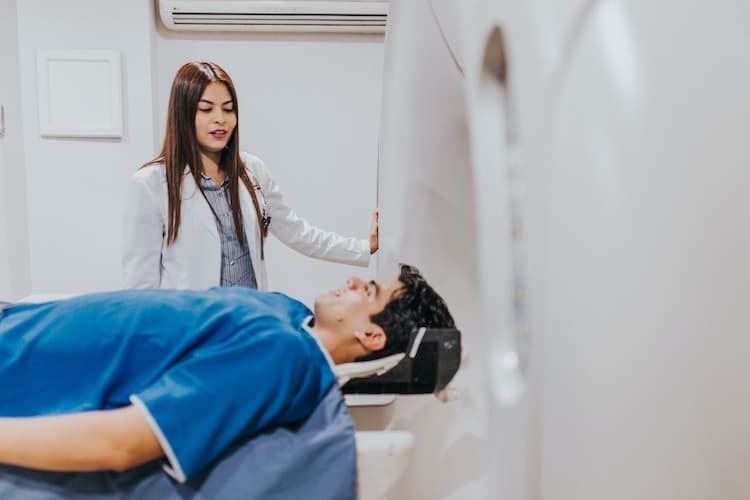Unraveling the Complexities of Multiple Sclerosis
If you or someone you know has a diagnosis of multiple sclerosis (MS), maneuvering through the multitude of inquiries and uncertainties may prove to be a daunting task.
This all-encompassing guide’s objective is to furnish an in-depth comprehension of multiple sclerosis, encompassing its fundamental facts, potential causative factors, demographics, classifications, manifestations, diagnostic processes and the treatments currently accessible.

What Will We Learn?
What is Multiple Sclerosis
Multiple sclerosis affects the central nervous system and occurs when the body’s immune system mistakenly attacks healthy tissue within the central nervous system.
This misguided attack results in harm that disrupts the transmission of nerve signals. Consequently, various symptoms manifest due to this disruption.
Symptoms in Multiple Sclerosis arise from damage within the central nervous system, leading to inflammation.
This inflammation affects the myelin, oligodendrocytes and underlying nerve fibers. Symptoms may be temporary or permanent and their severity can worsen over time.
Diagnosing MS
Magnetic resonance imaging (MRI) and the examination of spinal fluid emerge as essential tools for attaining a definitive diagnosis.
Yet, the precision and effectiveness of the diagnostic procedure can be notably improved when individuals opt for assessment at specialized centers, such as the Multiple Sclerosis Infusion Center in Westerville Ohio and The Boster Center for Multiple Sclerosis.
Multiple Sclerosis Infusion Center in Westerville, Ohio
As a bastion of proficiency in the realm of Multiple Sclerosis care, the Multiple Sclerosis Infusion Center in Westerville Ohio stands as a state-of-the-art facility. It is furnished with advanced diagnostic technologies and operated by healthcare professionals possessing specialized knowledge in multiple sclerosis.
Individuals receiving care at the Multiple Sclerosis Infusion Center in Westerville Ohio, enjoy the center’s dedication to delivering precise and prompt diagnoses, establishing a robust basis for formulating efficacious treatment plans.
The Boster Center for Multiple Sclerosis
Another prominent institution at the forefront of MS care is The Boster Center for Multiple Sclerosis. Renowned for its dedication to advancing the understanding and treatment of MS, this center combines clinical excellence with research innovation.
The Boster Center for Multiple Sclerosis is committed to offering comprehensive diagnostic services, utilizing the latest advancements in medical imaging and analysis.
Who Develops MS
While MS can affect anyone, certain patterns have been observed. Women are three times more likely to develop MS than men and it is prevalent in various ethnic groups.
Recent studies challenge previous assumptions, revealing higher rates of MS in Black Americans and the Hispanic/Latinx community. Genetic and environmental factors, such as low vitamin D and smoking, also contribute to the risk of developing MS.
How Many People Have MS
Approximately one million individuals in the United States and more than 2.8 million worldwide are currently living with MS. Recent prevalence studies offer a more precise count compared to previous approximations, indicating a rise in the number of affected individuals.
Continuous research endeavors, inclusive of neurological disease surveillance systems, are directed towards gaining a deeper comprehension of and tackling the global implications of MS.
Types of MS
MS presents in four basic disease courses:
- Clinically isolated syndrome (CIS)
- Relapsing-remitting MS (RRMS)
- Secondary progressive MS (SPMS)
- Primary progressive MS (PPMS)
Understanding the progression of these types is crucial for both patients and healthcare providers in developing effective management strategies.
Symptoms of MS
The symptoms are diverse and can vary in type, as well as severity from person to person. A few typical signs comprise weariness, numbness or tingling, issues with vision, challenges in walking and alterations in emotions. Identifying these signs is crucial for timely intervention and efficient management of symptoms.
Age of Onset
Many individuals receive a diagnosis of MS typically occurring between the ages of 20-40. However, it’s noteworthy that older adults and children may also experience the development of this condition. Recognizing the age of onset holds significance in pinpointing potential symptoms and executing strategies for early intervention.
Paralysis in MS
Contrary to common misconception, MS does not always lead to paralysis. The majority of individuals with MS do not develop severe disability and many can maintain the ability to walk with the help of aids. Understanding the varied outcomes is essential for managing expectations and implementing appropriate support.
Guiding MS Now
Initiating early treatment with FDA-approved disease-modifying drugs becomes pivotal for minimizing inflammation and lessening long-term disability. Furthermore, implementing strategies for symptom management, encompassing a health-conscious lifestyle, regular exercise and preventive care, contributes to overall well-being.
Collaborating with knowledgeable MS care providers ensures a comprehensive approach to effectively managing the disease.
Conclusion
Understanding multiple sclerosis involves navigating through its complexities, from its immune-mediated nature to its diverse symptoms and treatment options. Given the continual progress in healthcare research and advancements, the prospects for individuals dealing with MS are consistently getting better.
Through debunking misconceptions, raising awareness and offering precise information, we can lend our support to those impacted by MS as they navigate their path towards enhanced health and well-being.
See also: Self-Medication of OTC Drugs
